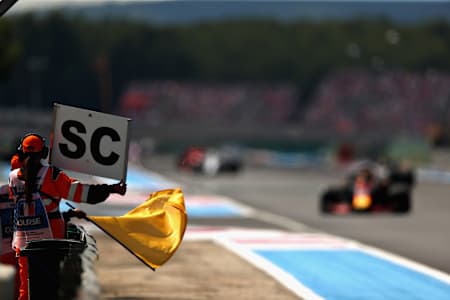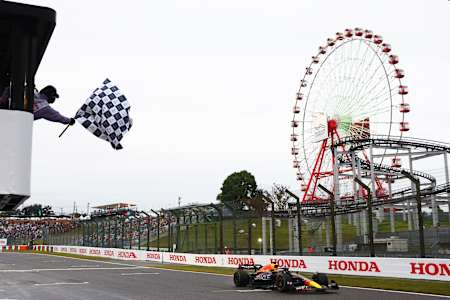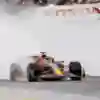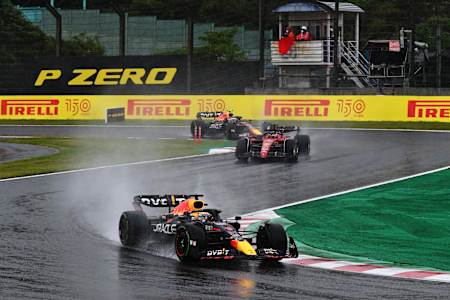Red Bull Motorsports

F1
Flags in Formula 1: What do they mean?
Formula 1 is a colourful spectacle, but there is more to some colours. We explain what the different flags waved by the stewards at the side of the track mean for the drivers and spectators.
It's time to refresh our memory a little and take a brief detour into the colourful world of flags in Formula 1. It is hard to imagine the premier class of motorsport without flags, after all, they are essential for the successful running of a Grand Prix.
With the help of the various flags and track marshals, the race steward can convey certain messages to the drivers along the race track. But the stewards can also take action themselves and wave the flag in the event of an incident.
Nowadays, the colours of the various flags are also displayed via huge LED screens along the track. And because it is easy to lose track of so many bright colours, we explain what the flags mean in Formula 1.
01
Green flag
The green flag is a real all-rounder and can be used in various ways, for example at the start of the race. You've probably noticed that just before lights-out, a marshal behind the starting grid runs from one side of the track to the other with the green flag. This signals that the start procedure can begin.
The green flag is also waved at the start of free practice and qualifying. In addition, F1 uses the green flag at the end of danger zones, or when the race resumes after a (virtual) safety car.
02
Yellow flag
The yellow flag signals danger on the track. When the yellow flag is waved, drivers must slow down and expect to take evasive action. In addition, overtaking is prohibited.
Depending on the severity of the situation, one or two yellow flags are waved. The single yellow flag is the most common. It is used, for example, when there is debris on or next to the track. The double yellow flag is usually used when a serious accident has occurred and the track is partially or completely blocked. During such phases, there may also be marshals on or next to the track.
With the double yellow flag, it is important that drivers reduce their speed significantly in order to be able to come to a stop if necessary. The yellow flag is held in Formula 1 until it is safe to do so again.
03
Red flag
In Formula 1 racing, a red flag is used to signal a halt or stoppage of the session or race. When the red flag is displayed, it indicates that the session or race has been temporarily suspended, and all drivers must immediately come to a stop on the track and proceed to a designated area.
The red flag is typically shown in response to an incident or unsafe conditions on the track that require the race to be stopped. This could be due to severe weather conditions, a serious accident, track blockage, or any other situation that poses a significant risk to the drivers or track officials.
When the red flag is displayed, drivers must reduce their speed and return to the pit lane or a specific area as instructed by race officials. They are not allowed to continue racing or overtaking other cars until the race is resumed. The red flag period allows the race organizers to address the situation, clear any hazards, and ensure the safety of all participants before the race can resume.
04
Blue flag
In Formula 1 racing, a blue flag is used to inform a driver that they are about to be lapped by a faster car. When a driver sees a blue flag being waved or displayed, it serves as a signal for them to yield to the approaching faster car and allow it to overtake them safely.
The purpose of the blue flag is to ensure that slower cars do not impede or obstruct the progress of faster cars during a race. When a driver sees the blue flag, they are expected to be aware of the approaching faster car and make way for it at the earliest safe opportunity, without excessively impeding its progress.
It's important for the lapped driver to yield to the faster car in a safe and predictable manner. This typically means moving to the side of the track and allowing the faster car to pass on a straight or in a designated overtaking zone. Ignoring blue flags or impeding a faster car's progress can result in penalties for the slower driver, as it is considered unsportsmanlike behavior and can affect the outcome of the race.
05
Chequered flag
In Formula 1 racing, the chequered flag is the traditional signal used to indicate the end of the race. When the leading car crosses the finish line after completing the designated race distance or duration, the chequered flag is waved to signify that the race has concluded.
The appearance of the chequered flag is an exciting moment for both drivers and spectators, as it indicates the completion of the competition. Once the chequered flag is shown, all drivers still on the track are required to complete the current lap and proceed to the pit lane. They must do so at a controlled speed and in a safe manner.
The chequered flag is often accompanied by various post-race procedures, such as a cool-down lap, where drivers may celebrate, acknowledge the crowd, or interact with their teams and fellow competitors. Once the cars have returned to the pit lane, the official race results are determined based on the positions of the cars at the time the leading car crossed the finish line.
It's worth noting that in certain situations, such as a race stoppage or a red flag period, the chequered flag may not be waved at the finish line. Instead, race officials may use alternative signals to indicate the official end of the race and determine the final positions.
06
Yellow-red striped flag
In Formula 1 racing, the yellow-red striped flag, also known as the "hazard flag," is used to indicate a slippery or hazardous track surface. When this flag is displayed, it warns drivers that there may be oil, debris, or other substances on the track that could affect traction and make the surface potentially dangerous.
The yellow-red striped flag is shown by track marshals at specific points around the circuit to alert drivers of the hazardous conditions ahead. It is typically waved or displayed stationary to capture the drivers' attention and urge them to exercise caution while approaching and traversing the affected area.
When drivers encounter the yellow-red striped flag, they are expected to adapt their driving style accordingly, reduce their speed, and be prepared for decreased grip levels. It serves as a warning to be vigilant and adjust their racing line or braking points to avoid potential accidents or loss of control.
It's important for drivers to respect the yellow-red striped flag and exercise caution until they have passed the hazardous section of the track and the flag is no longer displayed. Failure to acknowledge the flag and adjust driving behavior appropriately can lead to penalties or potential accidents.
Black flag with orange dot
The black flag with an orange dot is a flag used in Formula 1 racing to indicate a mechanical issue with a car. When this flag is shown to a driver, it means that their car has a technical problem that requires immediate attention, and they must return to the pits to address the issue.
The black flag with an orange dot is typically displayed by race officials at various points around the track. When a driver sees this flag, it serves as a signal that they need to exit the race and make their way to the pit lane as soon as it is safe to do so.
The flag is used to ensure the safety of the driver, other competitors, and track personnel. If a car has a mechanical issue that poses a potential danger to the driver or others on the track, it is important for them to stop racing and address the problem promptly.
Once the driver receives the black flag with an orange dot, they must follow the instructions and regulations of the race officials. Failure to comply with the flag's instruction can result in penalties or disqualification from the race. The driver's team will assess and attempt to resolve the mechanical issue so that the car can return to the race if possible.
Black and white flag
In Formula 1 racing, the black and white flag is used as a warning flag to indicate unsportsmanlike conduct or a breach of racing regulations. When this flag is shown to a driver, it serves as a cautionary measure to alert them that their driving behavior has been observed and deemed questionable by race officials.
The black and white flag is typically displayed alongside the car number on the start/finish line or shown by marshals at specific points on the track. It signifies that the driver has been involved in an incident or engaged in actions that are considered potentially dangerous or in violation of the racing rules.
The purpose of the black and white flag is to notify the driver that they need to modify their driving behavior to ensure fair competition and maintain safety standards. It acts as a warning to the driver to refrain from further unsportsmanlike conduct or rule infractions.
Although the black and white flag itself does not impose a penalty on the driver, it serves as a signal that their actions have been noticed and that further penalties, such as a drive-through or stop-and-go penalty, could be imposed if the behavior persists or worsens.
Drivers who receive the black and white flag should take it seriously, assess their driving actions, and make adjustments to adhere to the regulations and maintain a safe racing environment. Continuous disregard for the warning may result in additional penalties being imposed by race officials.
Black flag
In Formula 1 racing, the black flag is a flag with solid black color, and when displayed to a driver, it carries significant consequences. The black flag is the most severe flag used in the sport, and it indicates that the driver has been disqualified from the race.
When a driver sees the black flag being shown, it means that they have committed a serious violation or breached the racing regulations to such an extent that they are no longer allowed to continue in the race. The reasons for displaying the black flag can vary but often include dangerous driving, repeated rule infractions, or not adhering to penalties or instructions from race officials.
Once a driver receives the black flag, they are required to return to the pit lane immediately, stop racing, and retire from the event. Ignoring the black flag can result in further penalties or sanctions from race stewards.
The black flag is a severe measure implemented to ensure the safety and fairness of the race. It indicates that the driver's actions have crossed a threshold that is deemed unacceptable and jeopardizes the well-being of other participants or violates the integrity of the sport.
It's important for drivers to understand and respect the rules and regulations of the sport to avoid receiving the black flag and its associated consequences.
SC/VSC
Even though they are not technically flags, the SC (Safety Car) and VSC (Virtual Safety Car) signals should not be missing from the list. These flags are used to manage and control the race in the event of a hazardous situation or incident on the track. They are deployed to ensure the safety of the drivers and allow for the safe handling of the incident.
Safety Car (SC) Flag: When the Safety Car is deployed, it means that there is a significant incident on the track that requires the race to be neutralized. The SC flag is shown, and the Safety Car itself, a specially equipped car, is sent onto the track. When the SC is deployed, all drivers must reduce their speed significantly, follow the Safety Car in a single-file formation, and refrain from overtaking until further instructions are given.
The purpose of the Safety Car is to slow down the race and allow track officials to handle the incident, clear any debris, or make necessary repairs to ensure the safety of the track and drivers. Once the situation is resolved, the Safety Car will return to the pit lane, and the race will resume under normal racing conditions.
Virtual Safety Car (VSC) Flag: The Virtual Safety Car is an alternative to the traditional Safety Car deployment. When the VSC is implemented, the VSC flag is displayed to inform drivers that they need to reduce their speed significantly and maintain a specified delta time relative to a reference point on the track.
During a VSC period, drivers must stay within the prescribed time limit, which aims to maintain a controlled and safe speed across the entire track. The VSC helps to manage the race without the physical presence of a Safety Car on the track, minimizing disruptions and allowing incidents to be resolved more efficiently.
The deployment of the SC or VSC is at the discretion of the race officials and depends on the severity and nature of the incident. These safety measures are essential to protect the drivers, enable incident handling, and maintain a fair and competitive racing environment
Love F1? Grab the Red Bull TV app for free to catch all the latest racing coverage as well as documentaries and driver profiles.

9 min
Ricciardo takes on the Outback
The 'Honey Badger' in Oz – Red Bull Racing send driver Daniel Ricciardo to Melbourne's Albert Park circuit.









